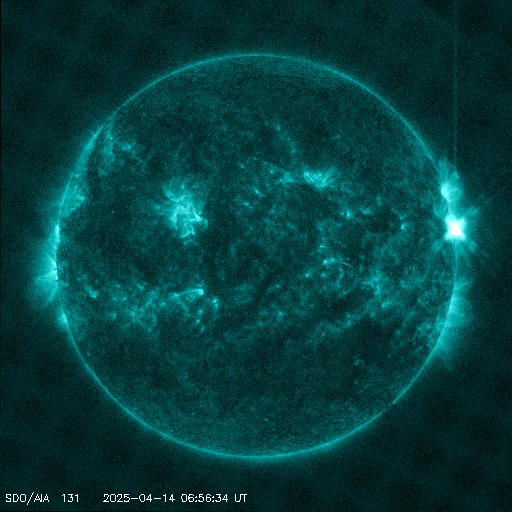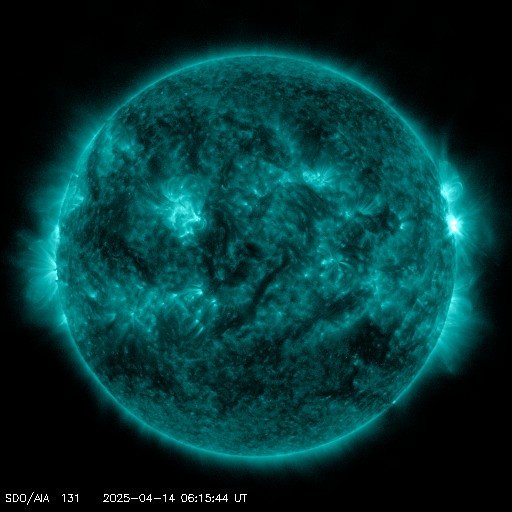Viewing archive of Thursday, 6 February 2020
Daily bulletin on solar and geomagnetic activity from the SIDC
Issued: 2020 Feb 06 1231 UTC
SIDC Forecast
Solar flares
Quiet conditions (<50% probability of C-class flares)
Geomagnetism
Quiet (A<20 and K<4)
Solar protons
Quiet
| 10cm flux | Ap | |
|---|---|---|
| 06 Feb 2020 | 071 | 017 |
| 07 Feb 2020 | 071 | 015 |
| 08 Feb 2020 | 071 | 007 |
Bulletin
X-ray flux remained below B level throughout the period. The Sun is spotless and no flaring is expected.
No Earth-directed CMEs have been observed in coronagraph data.
The proton flux levels were at background values and expected to remain so.
Solar wind showed the expected enhancements under the influence of a high speed stream from an extension of the southern polar coronal hole. Since midnight, Solar wind speed increased from 350km/s to 460 km/s. Total magnetic field reached a peak value of 11nT in the compression region, with Bz around -10nT for a while. The magnetic field phi angle was in the negative sector throughout the period. Solar wind speed is expected to rise further to a maximum of between 500-600 km/s over the next 24 hours before starting a slow return to background values.
Geomagnetic conditions reached active levels (NOAA Kp=5 for the 6-9UT period, while local K Dourbes remained 0-3). Unsettled to active conditions are expected over the next 24 hours before returning to quiet to unsettled conditions.
Today's estimated international sunspot number (ISN): 000, based on 18 stations.Solar indices for 05 Feb 2020
| Wolf number Catania | /// |
| 10cm solar flux | 071 |
| AK Chambon La Forêt | 008 |
| AK Wingst | 005 |
| Estimated Ap | 004 |
| Estimated international sunspot number | 000 - Based on 26 stations |
Noticeable events summary
| Day | Begin | Max | End | Loc | Strength | OP | 10cm | Catania/NOAA | Radio burst types | |
|---|---|---|---|---|---|---|---|---|---|---|
| None | ||||||||||
Provided by the Solar Influences Data analysis Center© - SIDC - Processed by SpaceWeatherLive
All times in UTC
Current data suggests there is a slight possibility for aurora to appear at the following high latitude regions in the near future
Edmonton, AB, Gillam, MB, Saskatoon, SK, Whitehorse, YT, Yellowknife, NTJuneau, AK
Latest news
Latest forum messages
Support SpaceWeatherLive.com!
A lot of people come to SpaceWeatherLive to follow the Sun's activity or if there is aurora to be seen, but with more traffic comes higher server costs. Consider a donation if you enjoy SpaceWeatherLive so we can keep the website online!

Latest alerts
07:09 UTC - Solar flare
Moderate M4.28 flare from sunspot region 4055
06:48 UTC - Radio Blackout
Minor R1 radio blackout in progress (≥M1 - current: M1.53)
06:24 UTC - Solar flare
Moderate M1.49 flare from sunspot region 4055
06:06 UTC - Radio Blackout
Minor R1 radio blackout in progress (≥M1 - current: M1.16)
04:45 UTC - Geomagnetic activity
Active geomagnetic conditions (Kp4) Threshold Reached: 04:29 UTC
Space weather facts
| Last X-flare | 2025/03/28 | X1.1 |
| Last M-flare | 2025/04/13 | M1.6 |
| Last geomagnetic storm | 2025/04/06 | Kp5 (G1) |
| Spotless days | |
|---|---|
| Last spotless day | 2022/06/08 |
| Monthly mean Sunspot Number | |
|---|---|
| March 2025 | 134.2 -20.4 |
| April 2025 | 132.1 -2.1 |
| Last 30 days | 132.4 -10.7 |





